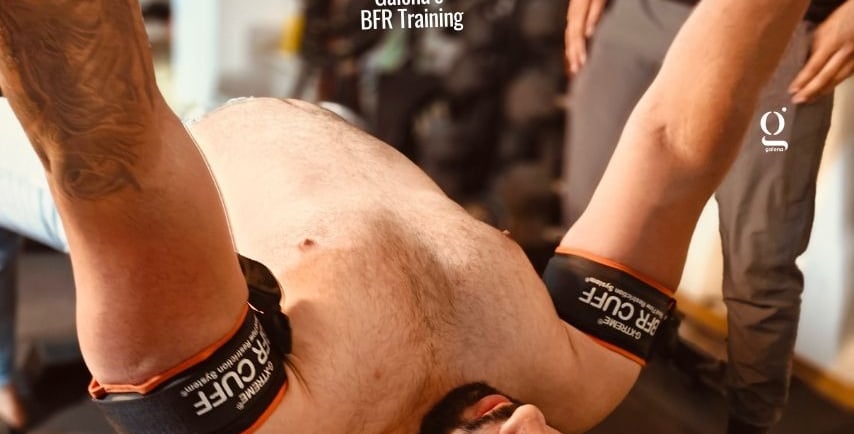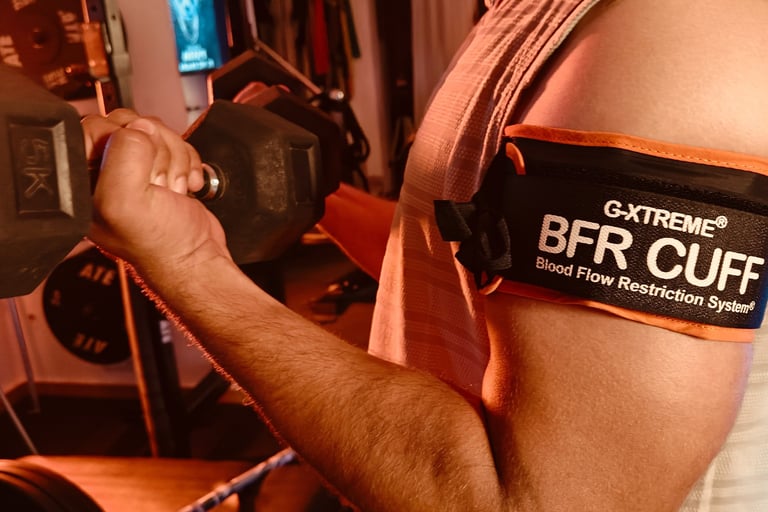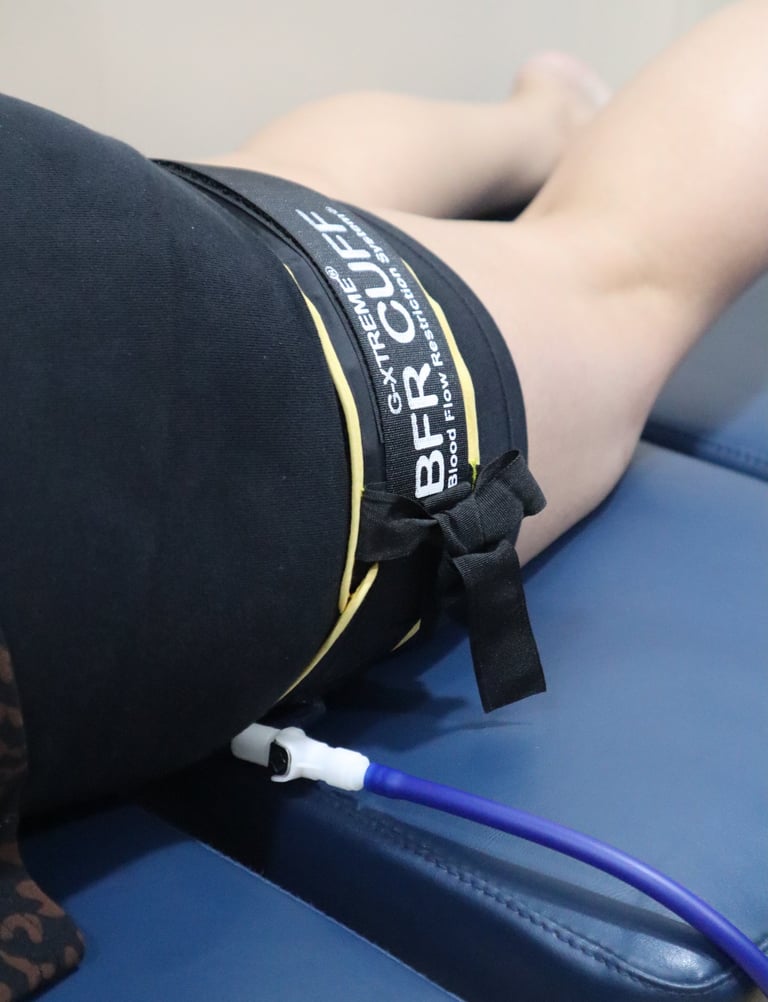What is Blood Flow Restriction (BFR) Training?
Discover blood flow restriction (BFR) training with Dr. Piyush Jain PT—a game-changing physiotherapy and rehab technique for muscle growth, injury recovery, and strength gains. Learn how BFR sessions work, who benefits, the science behind BFR, and find answers to 20 top FAQs for athletes and patients seeking safe, expert-led BFR training in India.
HEALTH
10/11/20255 min read


Blood Flow Restriction Training : Transforming Physiotherapy and Sport Rehab in India
In the ever-evolving world of sports rehabilitation and physiotherapy, Blood Flow Restriction (BFR) training stands out as a breakthrough. It’s not just another fitness trend—it’s a science-backed tool delivering real results for muscle growth, faster recovery, and safer rehabilitation. In India, Dr. Piyush Jain PT, an acclaimed physiotherapist and educator, has become synonymous with expert BFR training and education.
If you’ve heard the buzz about BFR training and wondered, “Is it right for me?”—read on. This article is crafted for athletes, patients, physiotherapists, and anyone curious about this advanced rehabilitative and performance technique.
What is Blood Flow Restriction (BFR) Training?
BFR training is a method where you apply specially designed cuffs or bands to your arms or legs to restrict—but not completely cut off—blood flow during exercise. Think of it as giving your tired muscles a little “pressure challenge” so they work harder, even with light weights or gentle movement.
Thanks to this controlled restriction, your body gets the same benefits as it would with heavy exercise: muscle growth, increased strength, greater endurance, and faster healing—with far less strain on the joints or surgical sites.
Why is BFR a Game-Changer for Rehab and Performance?
Let’s say you’re a patient fresh from knee surgery, an athlete with an overuse injury, or a senior wanting to stay strong. With BFR, you don’t need to “lift heavy” to get big benefits. Even gentle movements make your muscles release growth hormones and adapt as if you’d been hoisting heavy weights at the gym.
Great for post-surgery and injuries: Regain muscle mass, fight atrophy, and build function—safely and quickly.
Supports athletes during intense seasons: Boost performance or stave off declines during rest or recovery periods.
Empowers older adults: Improves strength and bone health without risky joint loads.
What Makes BFR Training Unique?
Galena Physiotherapy & Sports Performance Centre in Noida and heads the Galena Global Academy, where he’s taught and practiced BFR with athletes, patients, and clinicians alike. He brings an evidence-based approach, staying updated with global research, so you’re always in safe, expert hands.
You can expect:
Precise screening to see if BFR is right for you
Personalized protocols adjusting pressure, sets, and intensity
Meticulous monitoring to ensure comfort and quick progress
Integration with other cutting-edge physio techniques (like dry needling, IASTM, and therapeutic taping)
His BFR programs are tailored—no “one size fits all.” Every session matches your needs, goals, and medical history.
How Does a BFR Session Feel? What’s the Process?
A typical session with Dr. Piyush Jain begins with a friendly assessment and clear communication about what to expect. Next, cuffs or bands are placed at the upper part of an arm or leg, and pressure is calibrated just right. Then you’ll perform exercises (such as squats, curls, or leg presses) at lower-than-normal resistance, usually for more repetitions.
You might feel a gentle “squeeze” and muscle fatigue much sooner than usual. Some describe a mild ache or “exercise burn,” but sharp pain is never allowed.
Who Can Benefit from Blood Flow Restriction Training?
Athletes recovering from surgeries (ACL, meniscus, shoulder)
Post-fracture or immobilized patients fighting muscle wasting
Seniors wanting to keep muscle and bone strong, safely
Anyone with arthritis, tendon repair, or chronic weakness
Fitness lovers seeking muscle gains with less joint stress
The Science Supporting BFR Training
Multiple studies (and real-world success stories) show that BFR done at 20–30% of maximum load produces similar muscle and strength gains as traditional training at 70–80%. It triggers unique metabolic and hormonal responses—like greater lactate production and more growth hormone—that result in faster, more complete recovery and performance boosts.
Is Blood Flow Restriction Training Safe?
Yes—when supervised by a trained and certified professional like Dr. Piyush Jain. The key is to match pressure and protocol to the individual, do ongoing medical monitoring, and never push through pain. International research shows BFR is safe for most people, excluding those with certain vascular or clotting conditions.
Top 20 FAQs About Blood Flow Restriction Training
1. What is BFR training, and how does it work?
BFR training uses cuffs to reduce blood return from an exercising muscle, forcing the muscle to work harder—even at light resistance.
2. What are the main benefits of BFR training?
Faster muscle/tendon recovery, preserved strength during injury, improved muscle size, stronger bones, and less joint stress.
3. Is BFR only for athletes?
No, it benefits everyone—from post-surgery patients to seniors, to those with arthritis or chronic weakness.
4. Is BFR training painful?
You’ll feel mild pressure and muscle fatigue—a “burn” like exercise. It should never be sharply painful.
5. How long does a typical BFR session last?
Sessions usually last 15–30 minutes, depending on your protocol and how your body responds.
6. Can you do BFR at home?
Supervised sessions with a professional are best, especially when starting. Home programs may be possible later, under guidance.
7. How many times per week should I do BFR?
Most effective protocols use 2–3 sessions per week, with rest or light activity in between.
8. Are there risks or side effects?
Side effects are rare but can include numbness, tingling, or mild bruising. With correct screening and monitoring, serious complications are uncommon.
9. Who should avoid BFR?
People with blood clots, severe vascular disease, uncontrolled hypertension, current infections, or pregnancy.
10. Is BFR used for both upper and lower body?
Yes. It can benefit arms, shoulders, legs, or hips—each has specific cuff placement and protocols.
11. How quickly will I see results?
Some feel differences after 2–3 weeks, especially in strength and muscle tone.
12. Can BFR help after orthopedic surgery?
Yes, especially after ACL, knee, tendon, or muscle surgeries—helping muscle return and minimizing wasting.
13. Is BFR suitable for seniors?
Absolutely. It allows older adults to strengthen muscles and bones safely, using just body weight or low resistance.
14. Are there any medical conditions that BFR helps with?
Yes, including sarcopenia (age-related muscle loss), osteoporosis, chronic pain, and certain neurological disorders.
15. What are the risks of doing BFR unsupervised?
Incorrect use could cause nerve damage, bruising, or blood clots—always work with a certified provider.
16. Does BFR replace traditional strength training?
Not entirely. It’s best as a supplement or for those unable to lift heavy due to injury, pain, or surgery.
17. What equipment is used for BFR?
Specialized pneumatic or elastic cuffs—not regular resistance bands (which can be unsafe).
18. What does a BFR protocol look like?
Usually 4 sets: first with 30 reps, then 3 sets of 15 reps, with short rests and light weight—tailored per person.
19. Does insurance cover BFR therapy in India?
In most cases it’s covered as part of physiotherapy if prescribed for rehabilitation; always check your provider.
20. How do I find the best BFR specialist in India?
Seek certified, experienced providers with up-to-date equipment—like Dr. Piyush Jain PT in Noida.
How to Start BFR Training in India
If this approach aligns with your rehab or performance goals, start with a consultation at Galena Physiotherapy & Sports Performance Centre. Dr. Jain will create a plan just for you, guide each session, and adjust as your body adapts and grows stronger.
Blood Flow Restriction Training is a game-changer for anyone serious about faster, safer recovery and peak strength. Dr. Piyush Jain PT’s expertise ensures you get the science, safety, and support you need—so you can get back to what you love, or push through to that next level in your sport or fitness journey.




